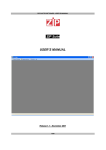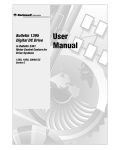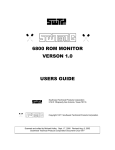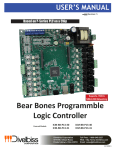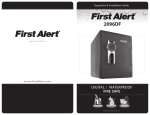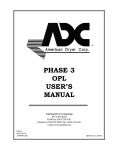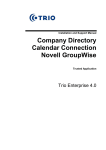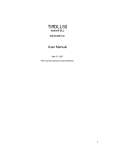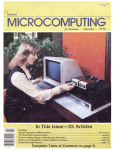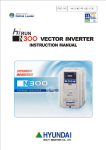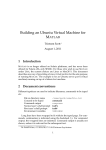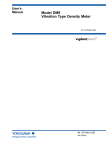Download DYNAMITE Disassembler User`s Manual
Transcript
DYNAMITE Disassembler User's Manual
1. INTRODUCTION
A disassembler is a program which, as the name implies, provides a
function opposite that of an assembler. An assembler takes text files
which you type in, and converts them to object files which can be used by
the computer. These object files, while perfect for a computer, are not
suitable for human consumption. Thus, the job of a disassembler is to
take an object file, and from it create a text file which can be
understood. Assemblers and disassemblers are therefore complementary
programs.
A disassembler can be useful for many jobs.
You might have a
program which needs to be modified, but have only an object file of the
code. With a disassembler, you can translate this object into a text
file, which you can then update as required. The disassembler will not
do the whole job, but a good disassembler will make the job infinitely
easier.
A good way to become a better programmer is to study the
programs of others, to encounter new methods of programming.
With a
disassembler, you can do this with very little trouble. Finally, this
disassembler in particular can come in very handy with a specific problem
encountered by 6800 users who are upgrading to the 6809, but don't want
to leave behind existing programs for the 6800. With the disassembler,
those programs can be disassembled, then reassembled under the 6809,
after making whatever changes need to be.
Disassembling can be a difficult job, which can be simplified by a
powerful disassembler. A simple disassembler may do nothing more than
translate object code into absolute source code, without supplying labels
to allow easy moving of the program to another part of memory.
While
adequate for small jobs, this type of disassembler will not suffice for
larger jobs, where the existence of labels can be a decided advantage, if
not a necessity.
Another needed ability of a good disassembler is the
ability to specify portions of a program as data instead of code which is
meant to be executed by the computer. Such data areas occur as strings
of ASCII characters for output or tables of byte or word data for
reference by the program.
If a disassembler attempts to disassemble
these data areas, incorrect code can be produced, or labels can be
generated where they need not be.
Finally, a useful addition to a
disassembler might be the ability to specify that any reference to
certain locations should be labeled not by an internally generated label,
but by some standard symbol name.
Often, a program will reference some
location in the operating system which is normally known by a certain
standard name. If the disassembler uses this standard name instead of a
less meaningful label, a program becomes much easier to understand on
first reading.
Obviously, a disassembler cannot perform all of these functions
unaided. For example, a disassembler cannot know where all the data
areas in a program are located, but it can make it easier to find them.
Disassembling a program becomes a cooperative effort between you, the
user, and the disassembler. A well designed disassenbler can make this
interaction relatively easy, maybe even fun.
DYNAMITE Disassembler User's Manual
DYNAMITE is such a disassembler. It has many abilities not usually
found in a disassembler, and can make your disassembly jobs much more
agreeable.
All of the above mentioned functions are available, as well
as many others. A partial list of DYNAMITE's abilities are
-Runs under FLEX 9.0(TM) for the 6809.
-Can disassemble both 6800 and 6809 object files.
-Produces source code
original binary file.
which,
when
reassembled,
is
identical to the
-Automatically produces labels for any memory references within a
program. External labels are defined by EQU statements grouped together
at the start of the text file.
-Any label can be given a standard name, which is printed instead of the
program-generated label name. In the default configuration, references
to standard FLEX locations will be given their standard names,
i.e.
a
jump to-the warmstart entry of FLEX will be disassembled as
JMP WARMS
You can define standard names for additional labels, or use different
labels in place of the default assignments in a particular program.
-Any block of code within a program can be treated as data.
can be defined as any of four different varieties:
Such an area
-ASCII data areas will produce FCCs, with strings automatically
delimited, and ASCII control characters referred to by their
standard names.
-Byte data areas will produce FCBs of hex data bytes.
-Label data areas will produce FDBs of labels references to the
program. Many programs have data tables in them which are used for
indirect addressing or for performing multi-direction jumps. Such
tables are best disassembled as a series of labels.
-Word data areas will produce FDBs of hex data double bytes.
-You can specify the boundaries for data areas within a program in two
ways. The data area addresses can be input interactively at the
beginning of a disassembly, or can be read from a disk text file which
has been set up previously.
-The output from DYNAMITE can be directed to the output device or to a
disk text file. The text file created has all extra spaces deleted to
save disk space.
-The output listing can be line numbered or paginated.
-To help in finding the data areas in a program, the ASCII equivalent of
------------FLEX is a trademark of Technical Systems Consultants, Inc.
DYNAMITE Disassembler User's Manual
the code being translated can be printed alongside the source line.
2. TERMS
2.1 FILES
DYNAMITE uses several files to perform disassembly jobs. Initial
definitions for these files follow (more complete definitions are given
in the instructions):
INPUT FILE is
disassemble.
the
binary
object
file which
DYNAMITE is directed to
OUTPUT FILE is the text file which is optionally created by DYNAMITE to
hold the disassembled code for further editing.
COMMAND FILE is an
address boundaries
the command file
(below) to use, as
FLEX commnand line
optional text file which contains lines specifying the
and types of data areas within a program. Also within
are the lines specifying the user defined label files
well as lines specifying options normally sent via the
to specify default options.
LABEL FILE is a binary file which sets up the equivalence between memory
addresses and standard symbol names for those addresses. DYNAMITE
defaults to using label files which name the standard FLEX locations.
The default file used is DISLBL09.BIN for 6809 code, and DISLBLOO.BIN for
6800 code. You can specify a single label file to be used in addition to
the default label file, or to be used in place of the default.
2.2 CONVENTIONS
As
is
standard in most 6809 program documentation, certain
conventions will be used in declaring the format of user directions for
DYNAMITE. Angle brackets (<>) will-be used to enclose essential elements
of a statement. Square brackets ([]) will be used to enclose optional
elements.
3. THE FLEX COMMAND LINE
The full syntax for calling DYNAMITE from FLEX is as follows:
+++DYNAMITE <input file> [<output file>] [<options> [+<command file>]
All of the files default to the working drive.
DYNAMITE Disassembler User's Manual
The <input file> is the file from which the object code in read. It
has a default extension of .CMD. As normal, another extension or drive
may be used by specifying it in the file name. Some examples:
+++DYNAMITE PROG
Default to PROG.CMD on working disk
+++DYNAMITE 0.PROG.BIN
Override defaults on filename
If the <output file> is not specified, but disk output is enabled,
then the output file will default to the name of the input file, with the
extension .TXT.
The <output file>, if specified, defaults to a .TXT
extension. If the output file already exists, then DYNAMITE will ask if
the existing file should be deleted:
+++DYNAMITE PROG PROGSRC.TXT
output file exists - Delete It (Y-N)?
If N is typed, then DYNAMITE will stop and return to FLEX.
If Y is
typed, the file will be deleted and a new text file created. If anything
else is typed, the question will be re-asked.
<options> specify a list of disassembly options on the command line.
The list must start with a plus sign ('+'), not have any embedded spaces,
and contain the following option switches in any order.
A
Print the ASCII equivalent of the code on the source line.
These
characters will be printed between the code bytes in hex and the
label field. Illegal ASCII characters will be replaced by a period
in this field.
B
Prompt the user for the data area boundaries.
This directs
DYNAMITE to enter an Interactive mode, requesting data area types
and addresses from the user. The prompting format is detailed in
the next section.
D
Do not create a text file on the disk.
created even if a name is specified.
G
Do not generate extra lines of code bytes when more than four bytes
are in an FCC, FCB, or FDB. Some data area disassembled code may
normally require more than one line to list all of the code bytes
in hex.
If this option is enabled, only one line with the first
four code bytes is printed.
L
Do not send a disassembly listing to the output device.
N
Generate line numbers in the output listing. The line number is
decimal number printed at the start of the source line.
P
Enable pagination. You will be prompted for a title, which will be
printed at the top of every page.
The title can be up to 32
characters long. Any excess over 32 characters will be ignored.
If pagination is enabled, the listing output is formatted for 66
The output file will not be
a
DYNAMITE Disassembler User's Manual
line pages, with a heading line, several blank
lines, and a form feed at the bottom of each page.
lines,
54 code
S
Prompt for the segment to disassemble.
It is possible
to
disassemble only a portion of the code, and ignore the rest of the
program. This option would be helpful if a large program is to be
disassembled, and the resultant text file would be too large for a
single disk if the entire source was output. You will be prompted
for a beginning and ending address, and the disassembly will take
place only between these two addresses inclusive.
Z
Disassemble
default.
0-3
Set the disk drive to read the default label file, DISLBL09.BIN or
DISLBL00.BIN, from. Normally, the default label file will be read
from the same disk as DYNAMITE was read from. This is done by
retrieving the disk drive number from the system file control block
on entry, and assuming that DYNAMITE was loaded using this FCB. If
this is not true, or the default file should be read from a
different disk than that holding DYNAMITE, a 0, 1, 2, or 3 in the
option list will set the drive number to override the default.
the
program
for the 6800, not the 6809, which is the
The final element of the command line is the <command file>. This
is the file holding the predefined data
area boundaries and other
miscellaneous commands.
The format of this file is described in section
5. The command file has a default extension of .TXT.
If specified, the
file name must be separated from the rest of the command line by a plus
sign ('+'). This is not the same plus sign as that specifying the status
of the option list.
If no options are specified, two plus signs must
still be in the command line. For example:
+++DYNAMIITE OBJPROG ++CMDFILE
What follows are several examples
explanations of the effect of each call:
of
calls
to
DYNAMITE,
with
+++DYNAMITE PROGA +DAN
Disassemble program PROGA.CMD, from the working disk. Do not create any
disk file, but do list the disassembly. The listing should
be
line-numbered, and have the ASCII equivalent of the code printed in the
code line. This option list is normally used to determine where in a
program the data areas, especially the ASCII strings, are located, so
that a more accurate disassembly can be made.
+++ DYNAMITE OBJFILE.BIN +DNGB
Disassemble program OBJFILE.BIN, read from the working disk.
Do not
create a disk file.
The output listing should have line numbers, and
FDBs, FCBs, and FCCs should not run to extra lines.
Before the
disassembly starts, prompt the user for the addresses of data areas
DYNAMITE Disassembler User's Manual
within the program.
+++DYNAMITE TESTFILE.0 1.SRCFILE +ZLS
Disassemble program 0.TESTFILE.CMD, and create a text file 1.SRCFILE.TXT
for the source text. TESTFILE should be disassembled as a 6800 program,
not 6809. Do not print an output listing, and before disassembly begins
prompt the user for addresses between which the program should be
disassembled.
+++DYNAMITE FILEA FILEZ +PGN1 +FILEABND
Disassemble the program FILEA.CMD from the working drive, and store the
text output in the file FILEZ.TXT on the working drive. The output
listing should be paginated and have line numbers, and extra lines of
code generation should be suppressed. Before disassembly starts, the
command file FILEABND.TXT from the working drive should be processed.
The default label file, DISLBL09.BIN, should be read from drive 1,
regardless of the disk that DYNAMITE was read from.
4. USER INPUT BEFORE THE DISASSEMBLY
Three options, the B, P, and S options, require user input before
the disassembly can begin. The format of that input will be described
below.
4.1 THE TITLE INPUT
The first user input, if pagination is enabled, will be the title to
be printed at the top of every page. DYNAMITE will print the prompt
Title?
and wait for input from you. Now type in the title you want, then press
RETURN. The title can be at most 32 characters long, so any excess typed
in is simply ignored.
4.2 THE DATA AREA BOUNDS INPUT
The next user input is that required by the B option. DYNAMITE will
enter an interactive mode enabling you to specify the addresses of data
areas within the program to disassemble. DYNAMITE will print the prompt
Data Segment Type: Ascii, Byte, Label, Word, Reset, or Proceed?
and wait for your response. Now enter the command for the type of the
text data area. Only the first letter of the type must be given, as that
DYNAMITE Disassembler User's Manual
is all
are:
that is checked.
The meaning of the commands in the type prompt
A
This declares a data area to be ASCII, so that it will be
disassembled as FCCs. ASCII control characters will be generated
using their standard names, with EQU statements collected at the
start of the program. Other unprintable ASCII characters will be
printed as two digit hex bytes, preceded by a dollar sign '$'.
For the 6809, all of these elements will be generated together in
FCCs, separated by commas, since this syntax is allowed by the TSC
Mnemonic Assembler. For the 6800, though, this format is illegal,
so unprintable ASCII characters will be generated on FCB lines
within the FCC data area.
B
This declares a data area to be byte data, so that it will be
disassembled as FCBs. Each byte in the data area will be printed
with two hex digits preceded with a dollar sign. A maximum of
eight bytes will be generated in each FCB.
L
This declares a data area to be label data, so that
disassembled as FDBs of labels. Each double byte in the
will be printed as a label, and that label will
elsewhere in the output. This is useful for jump tables
of indirect addresses.
W
This declares a data area to be word data, so that it will be
disassembled as FDBs of constants. Each double byte in the data
area will be printed as four hex digits preceded with a dollar
sign.
For both the label and word segments, a maximum of four
words will be generated in each FDB.
R
This does not specify a data area type, but instead directs
DYNAMITE to erase all data area specifications input so far, and
start over on the bounds input from scratch. Due to the structure
of the data area bounds processing, it is not possible to back up a
single step in the prompting sequence, so the only recourse if an
error is made is to reset everything to the start and reenter all
the data area bounds.
P
This directs DYNAMITE to proceed from the prompting sequence to the
next action.
In other words, stop prompting for data area
addresses and continue with the disassembly.
it will be
data area
be defined
or tables
Any illegal type character will be ignored, and the prompt reissued.
The A, B, L, and W type characters require a pair of addresses to be
input.
These are the first and last address in the data area. DYNAMITE
will first prompt with
Starting address?
to which you should respond with the hex address of the start of the data
area. Next, DYNAMITE prompts
DYNAMITE Disassembler User's Manual
Ending address?
to which
area.
you
should respond with the hex address of the end of the data
If the type character entered was not P, Proceed, then the prompt
will be reissued so that the next data area can be specified.
4.3 PROMPTING FOR THE SEGMENT TO DISASSEMBLE
If the text of a disassembly would be too large to save on a single
disk, it can be split up using the S option. If the S option is
specified, then DYNAMITE will prompt with
What are the bounds of the segment to disassemble?
DYNAMITE then prompts for the first and last address of the segment to
disassemble, in exactly the same way as the address pairs are prompted
for while inputting the data area bounds.
5.
THE COMMAND FILE
While you can always specify the addresses of a program's data areas
by invoking the B option, this requires that you enter all of the data
area bounds every time you disassemble the program. This is acceptable
for small programs, but can be a substantial job for any large programs.
The entry of the specifications may take several minutes each time, and a
single error would require starting over from scratch. To make your job
easier, DYNAMITE has the ability to read the data area specifications
from a text file, as well as from the terminal at run time. This is the
main function of the command file. You also use the command file to
specify the name of a label file,which is to be used in addition to the
default label file, or as a replacement for the default.
Finally, the
command file can also be used to specify options so that they need not be
declared in the FLEX command line for every disassembly.
The command file should be created as a series of command lines,
each holding a single command. The command character should be the first
character in the line, and be followed by whatever parameters the line
requires. The various commands which are accepted within the command
file are:
+ <options>
This command line specifies a list of options, whose allowable
values are identical in meaning to the options specified in the
FLEX command line.
This command is used for options which would
always be specified for a program being disassembled. For example,
a common usage of the options command would be to specify a program
as 6800 code, so that you do not need to remember to do this on
DYNAMITE Disassembler User's Manual
every disassembly. The command in this case would be '+Z'. All of
the options for the FLEX command line are legal within the command
file except for the B, D, P, and S options. These are not allowed
because, for the D command, any disk option file has already been
opened before the command file is processed, and for the B, P, and
S options, all user input has been requested before the command
file is processed.
A <start addr>-<end addr>
This command line specifies the addresses of a data area to be
disassembled as FCCs or ASCII data.
As such, its effect is the
same as the A type character entered in response to the B option.
<start addr> and <end addr> are the hex values of the first and
last addresses of the data area being specified, with the first
address less than or equal to the last. The addresses should be
separated by a dash, '-', without any spaces between them. For
example, to declare the zero page of memory as an ASCII data area,
the commands 'A 0-FF' or 'A 0000-00FF', would be used.
B <start addr>-<end addr>
This command line specifies the addresses of a data area to be
disassembled as byte data in FCBS. Its result is the same as the B
command in the user data area specification. The parameters take
the same format as for the A command line.
L <start addr>-<end addr>
This command line specifies the addresses of a data area to be
disassembled as FDBs of labels. Its result is the same as the L
command in the user data area specification. The parameters take
the same format as for the A command line.
W <start addr>-<end addr>
This command line specifies the addresses of a data area to be
disassembled as FDBs of words, or double bytes. Its result is the
same as the W command in the user data area specification. The
parameters take the same format as for the A command line.
S <label file>
This command line specifies the name of a label file to be used in
place of the default label files, DISLBLO9.BIN or DISLBL00.BIN.
The default label file is always used if this command is not
issued.
The file name should have the standard FLEX file name
format. The file will default to the working drive, with a default
extension of .BIN. A special form of the S command is simply 'S',
with no file specified. If such a command is found, then no label
files will be used, and all labels in the disassembly will be
assigned program-generated names.
T <label file>
This command line specifies the name of a label file to be used in
addition to the default label file. The file name must be in the
standard FLEX format, and defaults to the working drive with an
extension of BIN.
DYNAMITE Disassembler User's Manual
The +, A, B, L, and W command lines may occur as many times as is
necessary within the command file, and do not have to be in any
particular order. Only one label file can be used in place of or in
addition to the default label file, so only a single S or T command may
be used. The command file can only have one S command, one T command, or
neither.
You cannot specify both the S and T options within a single
command file.
You may also include
asterisk, '*', in the command
ignored by the command file
or to format the command file
As an example of
following command lines:
a
blank lines or lines beginning with an
file wherever desired.
These lines are
processor, and can be used as comment lines
for easy viewing and editing.
command
file,
consider
the
effect of the
+ZG
* Data areas within the code
B A102-A104
W A105-Al08
L A233-A240
A A241-A27F
* Use an additional label file
T LBLFIL.BIN
The first command line declares the program being disassembled to be 6800
code, and directs DYNAMITE to suppress extra generation of code byte
lines for FCCs, FDBs, and FCBS.
The second line, starting with an
asterisk, is a comment line, ignored by DYNAMITE.
The third through
sixth lines declare four data areas within the program, one of each data
area type. The code from A102 to A104 should be disassembled as bytes in
FCBs. The bytes from A105 to A108 should be disassembled as two words in
FDBs. The bytes from A233 to A240 should be disassembled as seven labels
of FDBs. Finally, the bytes,from A241 to A27F should be disassembled as
ASCII data, in ASCII strings or as ASCII constants. The seventh line is
another comment line, and is ignored. The eigth line specifies a label
file, LBLFIL.BIN, to be read from the working drive and used in addition
to the default label file.
6.
THE
LABEL FILE
Normally, you don't have to worry about the assignment of standard
names to predefined memory addresses.
This function is automatically
taken care of by DYNAMITE, which will refer to FLEX addresses by their
normal names. You may want to expand the scope of the assignments,
though, either for a single program or for all disassemblies. For a
single program, this involves creating a custom label file for the
program, and placing the name in an S or T command within the command
file. To change the equivalences for all disassemblies, you will have to
modify the default label files, DISLBLO9.BIN or DISLBL00.BIN.
To
accomplish either function, you must know the format of the label files.
DYNAMITE Disassembler User's Manual
DYNAMITE label files must be binary object files, with code produced
by an assembler. To create a label file, you must first type in an
assembler source file, from which the binary file is produced. The label
source file should be a series of pairs of FCCs and FDBs. The FCC in a
pair specifies the standard name for a location, while the FDB specifies
the location value. The name FCC must assemble as six data bytes.
If
the name is less than six bytes long, it should left justified in the FCC
with spaces padding the unused name bytes.
The FDB should specify a
single word address.
The last entry in the file should be a 'name' of
six spaces, that is, an empty name, followed by an FDB specifying a zero
address.
As an example, consider a small label file, assigning the name
'VN' to address C102, the name 'STARTL' to address C100, and the name
'MEMHI' to address FFFF. The assembler source file would be set up as
follows:
FCC
FDB
FCC
FDB
FCC
FDB
FCC
FDB
"VN
"
$Cl02
"STARTL"
$C100
"MEMHI "
$FFFF
"
"
$0000
Remember when creating the label source file that all name FCCs must be
six characters long, and that the list of equivalences must be terminated
with a name of six spaces.
Once the label source file is created, it must be assembled to
create the binary label file. The name of the label file can then be
used within command files for any disassemblies.
The disk on which DYNAMITE has been sent to you also contains the
source files from which the default label
files
were
created,
DISLBL09.TXT and DISLBL00.TXT.
You can study these files to better
understand how label files should be set up. If desired, you can modify
these files, so that a different set of default standard label names can
be used. You will also find three other source label files, along with
the binary label files themselves. MFLEXLBL.TXT is the label source file
of label assignments for MINIFLEX(TM), a predecessor of the FLEX
operating system on the 6800. SWTBGLBL.TXT is the label source file of
label assignments for SWTBUG(TM), the system monitor in SWTPC 6809
computer systems.
SBUGLBL.TXT is the label source file of label
assignments for S-BUG(TM), the system monitor in SWTPC 6809 computer
systems. These three label files, if needed, can be used in three ways.
First, the text files can be used as starting points for custom label
files that you create. Second, the binary label files can be appended
onto existing label file segments to create a new label file. Note that
if this is done, the label file segment cannot have the terminating entry
of a blank name, and the standard label file you are using must be
appended last, since all are shipped with the terminating entry supplied
-------------------MINIFLEX is a trademark of Technical Systems Consultants, Inc.
SWTBUG and S-BUG are trademarks of Southwest Technical Products Corp.
DYNAMITE Disassembler User's Manual
within them . Finally, either standard label file may
since all have the correct format for label files.
be
used
as
is,
7. DISASSEMBLY PARTICULARS
There are several particular attributes of DYNAMITE which are useful
to keep in mind when disassembling.
DYNAMITE is a three pass disassembler.
On the first pass, the
object code is searched for memory references, which are to be translated
as labels. As well as the obvious memory references, such as the direct
or extended addressing modes, DYNAMITE regards the immediate addressing
mode using the IX, IY, U, or S registers as memory references. Thus, a
LDX # (load IX immediate) encountered within the object code will
generate a label for the immediate value. This ensures that the vast
majority of labels will be picked up.
Unfortunately, this also means
that an immediate load of those registers with data will also generate
labels, when this was not what was desired. For instance, in some code,
IX is loaded with a constant to control a loop count, as in LDX #256.
This will be disassembled as LDX #L0100, where L0100 is the label
assigned a reference to address 256, $100 in hex. Thus, there will
usually be some labels generated which are actually data values instead
of memory locations.
An exception to the generation of labels from
immediate addressing is in the immediate mode with ACCD, as in ADDD #1.
Since ACCD is almost exclusively used for data manipulation instead of
addressing, immediate references are always disassembled as data.
While
this may, very rarely, miss a label which should have been generated, it
will prevent the generation of many unneeded labels.
The second pass of DYNAMITE does not attempt to disassemble the
code but simply flags all labels found in pass 1 as internal or
external.
Internal labels are those whose value is the address of code
within the program, while external labels are those not occuring ,within
the program as code addresses.
This pass is required so that all
external labels can be defined using equate statements at the beginning
of the disassembly listing.
The third pass of DYNAMITE creates the actual disassembly code, both
the disk file and the output listing. The output has four main parts.
First, all standard labels, whose names were read from the label files,
were referenced within the code, and are external to the program, are
grouped together and defined using equates. Second, all ASCII equates
are grouped together. If any ASCII data areas were defined, and control
characters were encountered within these areas, then the standard names
for the control characters are used in the FCC statements. These
standard control character names are defined in this section of the
output. Third, all external labels without standard names are defined by
equates. This output section should be studied carefully, because any
generated labels which should really be data will normally show up in
this equate segment. If a label is defined which does not appear to be a
true legal memory reference, check in the actual disassembly for all
DYNAMITE Disassembler User's Manual
references to the,label and determine for yourself if it should actually
be a data value.
The fourth output section is the main section, the
actual disassembly. This will be a series of assembler-compatible source
lines.
If any lines are referenced in the code, then the internally
generated label will be placed in the label field of the source line.
All label references appear either as a standard name, if the value was
found in a label file, or as an L followed by a four digit hex number,
whose value is the reference address. Thus, references to address $1234
will generate a label of L1234.
The code produced by DYNAMITE should always reassemble into code
which is identical with the original source file. Some addressing modes,
though, can generate either 8 bit references
or 16 bit references,
especially on the 6809. To ensure that such references will assemble to
code with the same reference bit length, DYNAMITE will generate forced
addressing where required. This can be done only for the 6809, and is
compatible with the forced addressing method expected by TSC's Assembler.
Thus, all direct references, as well as all 8 bit PCR relative addressing
will have the 'force 8 bit addressing' character, the less than sign,
'<', before the label. For example, a direct load into ACCA from address
$55 will be disassembled as LDA <L0055. Also, all 16 bit references for
which 8 bits suffice will have the 'force 16 bit addressing' character,
the greater than sign, '>', before the label. An extended store of IX to
address $33 will be disassembled as STX >L0033.
8.
A
DISASSEMBLY EXAMPLE
To help you understand the procedure for disassembling a program, a
fairly routine example which uses many of DYNAMITE's abilities will be
discussed. The program to be disassembled will be written in 6800
assembly language, and will be converted, using DYNAMITE, to run under
the 6809 with FLEX 9.
The process of disassembling a program with DYNAMITE is usually a
multi-step procedure. First, you need to determine where the data areas
occur within a program. To do this, disassemble the program, suppressing
disk output and generating the ASCII equivalent of code in the listing.
By studying this listing, all of the ASCII strings can be easily found,
and some idea of the location of other types of data areas can be formed.
For instance, most programs running under FLEX will start with a branch
instruction over the version number and other data variable areas.
Such
an area can be defined as some combination of byte and word length data
areas. Once an idea is formed of where the data areas occur, the program
can be disassembled again, this time with the D and B options, so disk
output is again suppressed, but this time prompting you for the data
areas discovered in the first disassembly. This disassembly will be much
closer to the final version, and any data areas missed the first time can
usually be found now. Finally, you can create a command file with the
final version of the data area boundaries, and disassemble the program
once more, this time using the command file and creating a disk text
file.
DYNAMITE Disassembler User's Manual
If you are converting a program from 6800 to 6809, the next step
would be to edit the text file. Since all external labels are grouped
together, it is a simple matter to update all FLEX 2.0 references at the
start of the program to FLEX 9.0 addresses, usually just by changing
every $A to $C, $B to $D. Also, find all of the ORG statements within
the text, and update theg as needed. Once this is done, simply assemble
the program using the 6809 assembler. Your conversion is complete.
The example disassembly will follow this method. All of the files
referred to below exist on the disk on which DYNAMITE was shipped, so
follow along.
The first step, as outlined above, is to disassemble the program
with ASCII generated, to find the data areas. The command to do this is
(assuming that DYNAMITE and the standard label files are on the system
drive, TESTFILE.BIN on the working drive):
+++DYNAMITE TESTFILE.BIN +DANZ
This will disassemble the program for the 6800, suppress disk output, and
add line numbers and ASCII code equivalents to the listing. The listing
produced can be found on the next page.
DYNAMITE Disassembler User's Manual
1
2
3
4
5
6
7
8
9
10
11
12
13
14
15
16
17
18
19
20
21
22
23
24
25
26
27
28
29
30
31
32
33
34
* DISASSEMBLY BY DYNAMITE OF 1.TESTFILE.BIN
* STANDARD PRE-NAMED LABEL EQUATES
AD03
AD1E
WARMS
PSTRNG
EQU
EQU
$AD03
$AD1E
* EXTERNAL LABEL EQUATES
A100
A100
A102
A103
A104
A105
A106
A109
A10C
A10F
A112
A115
A116
A117
A118
A119
A11B
A11C
A11D
A11E
A11F
A120
20
01
00
00
00
B7
BF
CE
BD
7E
54
45
53
54
20
54
52
49
4E
47
04
04
A103
A106
A115
AD1E
AD03
53
A16E
LA16E
.
.
.
.
.
...
...
...
...
~..
T
E
S
T
S
T
R
I
N
G
.
A100
LA100
LA103
LA106
LA115
EQU
$A16E
ORG
BRA
NOP
FCB
FCB
FCB
STAA
STX
LDX
JSR
JMP
LSRB
FCB
COMB
LSRB
BRA
LSRB
FCB
ROLA
FCB
ASRA
FCB
END
$A100
LA106
$00
$00
$00
LA103
LA104
#LA115
PSTRNG
WARMS
$45
LA16E
$52
$4E
$04
LA100
DYNAMITE Disassembler User's Manual
By scanning the ASCII equivalent area of the listing, It is obvious
that the code from $A115 to $A120 is an ASCII string. The $04 at $A120
is an ASCII EOT, used by FLEX to terminate ASCII strings, and as such
should be included in the ASCII area. Next, most FLEX programs begin
with a branch past a data area, so the BRA LA106 at $A100 implies that
$A102 to $A105 should be either byte or word data. Since the instruction
at $A109 saves a 16 bit register, X, at LA104, you can assume that $A104
to $A105 should be a word type data area. Also, the byte following the
branch, the 1 at $A102, is normally the program version number, so you
can assume that $A102 to $A103 should be a byte type data area.
The remainder of the program seems to have disassembled properly, so
all of the data areas have probably been found. Note the external label
LA16E that has been generated. It is referenced only in the code that
should be an ASCII string, so that when we enter the data areas to
DYNAMITE, there should be no external labels.
Now, you can proceed with the second disassembly, this time entering
the data boundaries to DYNAMITE. Since there is little chance that a
third disassembly will be required, the output can be written to disk at
this time. The command sent to FLEX is now:
+++DYNAMITE TESTFILE.BIN +BNGZ
This command will have DYNAMITE input, via the keyboard, the data area
addresses found earlier.
Also, the output listing will be line numbered,
and extra lines for the ASCII string will not be generated. The program
will again be treated as 6800 code. Note that the ASCII equivalent area
of the listing is turned off, since it is no longer required.
After DYNAMITE has begun execution, the prompt for the entry of the
first data area type will be sent. You want to enter the area from $A102
to $A103 as byte data, so type a 'B', then RETURN. DYNAMITE will ask for
the starting address of the data area.
Type the characters 'A102', then
RETURN. The dollar sign is not required, since hex is assumed.
Next,
DYNAMITE will ask for the ending address of the data area. To this
prompt, answer 'A103', then RETURN.
DYNAMITE reissues the prompt for data area type. You should now
specify a word type data area from $A104 to $A105. Type 'W' in response
to the first question, 'A104' to the second, and 'A105' to the third. In
the same way, specify an ASCII type data area from $A115 to $A120. After
this, all of the data areas should have been entered. If at any point
you made a mistake which DYNAMITE did not immediately flag as an error,
type an 'R' to the data area type prompt and start over. Otherwise, the
data area specification is done. Type a 'P' to indicate that DYNAMITE
should Proceed to the rest of the disassembly process.
DYNAMITE will finish up its initial processing before beginning its
three passes. At the start of pass one, a RETURN, LINE FEED is sent, and
disassembly begins. After pass three is complete, the output listing
produced should be the same as the listing on the next page.
DYNAMITE Disassembler User's Manual
1
2
3
4
5
6
7
8
9
10
11
12
13
14
15
16
17
18
19
20
21
22
23
24
25
26
27
* DISASSEMBLY BY DYNAMITE OF 1.TESTFILE.BIN
* STANDARD PRE-NAMED LABEL EQUATES
AD03
AD1E
WARMS
PSTRNG
EQU
EQU
$AD03
$AD1E
* ASCII CODE EQUATES
0004
EOT
A100
A100
A102
A103
A104
A106
A109
A10C
A10F
A112
A115
A120
20
04
01
00
0000
B7
A103
BF
A106
8E
A115
BD
AD1E
7E
AD03
54 45 53 54
04
A100
LA100
LA103
LA106
LA115
EQU
$04
ORG
$A100
BRA
FCB
FCB
FDB
STAA
STS
LDS
JSR
JMP
FCC
FCB
LA106
$01
$00
$0000
LA103
LA106
#LA115
PSTRNG
WARMS
"TEST STRING"
EOT
END
LA100
DYNAMITE Disassembler User's Manual
This latest disassembly is the final one required. All of the data
areas are formatted correctly, and the output on disk is ready for
editing so it can be updated to run on the 6809. Thus, you next edit the
program TESTFILE.TXT.
The first thing to be done in fixing the text is to update the
addresses of the FLEX variables from those used by FLEX 2 to those of
FLEX 9. Thus, the equate addresses given for WARMS and PSTRNG should be
changed from $AD03 and $AD13 to $CD03 and $CD13 respectively. Also, the
origin address for the program should be changed from $A100 to $C100,
moving it into the FLEX 9 command file buffer. This is all the editing
which must be done, but you may chose to change all the labels from LAxxx
to LCxxx, so that they reflect the actual, new addresses, not the old
ones. This is not necessary, though, and may not always help much since,
because 6800 and 6809 source code lines do not always translate to the
same number of bytes, the labels may still not reflect the correct
addresses.
Once the editing is complete, assemble the
using the TSC Assembler, the command might be
file
TESTFILE.TXT.
If
+++ASMB TESTFILE TESTFILE.CMD +GN
or any other such line creating a 6809 type CMD file. Now execute the
new command file, which should simply type the ASCII string 'TEST STRING'
and return to FLEX. The conversion of a 6800 program to the 6809 is
complete.
While other programs to be disassembled will not be as simple as the
example program, the procedure remains the same. Thus, as long as you
are careful in finding the data areas within a program, practically any
program can be disassembled and updated to run as you wish.
As a further example, listed below are the lines which would be
placed in a text command file so that the prompting for data areas need
not be done at DYNAMITE run time. The command file would have the lines:
+ZG
B A102-A103
W A104-A105
A A115-A120
This specifies that the program being disassembled contains 6800 object
code, with data areas of type and location as determined earlier. If the
command file has been called TESTCMD.TXT (as it has on the DYNAMITE
disk), then the command to disassemble TESTFILE using the command file
would be
+++DYNAMITE TESTFILE.BIN +DN +TESTCMD
The options typed on the FLEX command line specify that no disk output is
to be produced, and that the listing should have line numbers. Note that
it is not necessary to declare the code as 6800, or suppress the
generation of extra code lines, since the first line of the command file
DYNAMITE Disassembler User's Manual
accomplishes this automatically.
9. ADAPTING TO YOUR SYSTEM
DYNAMITE has been written to run under FLEX 9, and has very little
which needs to be modified to adapt it for a particular system. There
are, however, two constants available for you to change:
1) The number of code lines printed per page
2) The first illegal ASCII character past $20
The first constant is located at address $003A. This is the number
of code lines to be printed on each page of the output listing when
pagination is enabled. This number does not include the lines required
for the page heading and top blank lines (5) or blank lines at the botton
of the page (determined by the physical page size). The skip to the next
page is done by outputting a form feed character, ASCII $0C, to the
output device. Presently, the constant for the number of code lines per
page is set to 54.
The second constant is located at $003B. This number is the value
of the first ASCII character past $20 which should not be printed.
This
value is referenced when printing the ASCII equivalent area of the
listing, and when printing ASCII strings generated in ASCII data areas.
If an ASCII character to be sent is greater than or equal to this value,
a period will be placed in the ASCII area, and the hex value of the
character will be placed in the FCC, or FCB for the 6800. This can be
useful for certain CRT terminals, which will not accept some ASCII
characters normally accepted by other terminals. For instance, Hazeltine
terminals, such as the 1500, use ASCII $7E as the escape sequence
character, so that $7E is never printed. If an attempt is made to print
this as a character, the output will not appear correct.
To change
DYNAMITE to accomodate the terminal, the constant at $003B should be
changed to $7E. The default value, as shipped, is $7F, so that deletes
are not treated as printable.
To change either constant, do the following:
First, using the FLEX MAP utility, determine the addresses at which
DYNAMITE loads. This will be from $0000 to some number around $2000.
Next, load DYNAMITE using the FLEX GET command, and enter the system
monitor with the MON command. Change the constants at $003A and $0033 as
required.
Go back into FLEX via the warm start address, $CD03. Finally
save the new version of DYNAMITE on the disk using the FLEX SAVE command.
For the start and end addresses of the program, use the values determined
by MAP in the first step. Remember to specify a transfer address of 0000.
DYNAMITE Disassembler User's Manual
1. DYNAMITE ERROR MESSAGES
There are two varieties of errors detected by DYNAMITE.
The first
of these is disk errors, as returned by FMS. The second is non-disk
errors, caused by some form of illegal user input detected by DYNAMITE.
Disk errors are at least two lines long.
particular file involved. The line has the form
Type
File
The first line gives the
Error
where 'Type' is one of Input, Output, Command, or Label. The last line
of the error is the output line returned by RPTERR in FLEX. Thus, if the
file ERRORS.SYS is on the system disk, then the error message will be a
complete text line, but if the file is not found, a line 'DISK ERROR
'nn' will be printed.
Non-disk errors print error messages found internal to DYNAMITE.
These errors give a description of the condition causing the program to
be aborted or interrupted.
All non-disk errors are detected in the
option processing portion of DYNAMITE, before the three passes begin.
Both types of errors may occur while the command file is being
processed. If an error occurs in the command file, then another line is
included in the error output. This line has the form
Command file line #nnn
where
nnn is the line number within the command file on which the error
occurred. This line is the second line in a disk error, the first in a
non-disk error.
Disk errors always cause DYNAMITE to stop execution. All files are
closed, then control is returned to FLEX via the warm start vector.
Non-disk errors normally result in the program being halted in the same
way.
If the error is caused by illegal input during the user input
portion of DYNAMITE, though, the error message is not usually a
terminating one, but just a request for re-input of the unaccepted data.
The non-disk errors detected by DYNAMITE are:
Syntax error in command line
Some unrecognizable character
command line calling DYNAMITE.
sequence
was
found
in
the
FLEX
Start > End, Reenter both addresses
When entering a pair of addresses, either data area boundaries or
the segment to disassemble, the starting address was greater than
the ending address.
The input is ignored, and you will be
re-prompted for both addresses.
Illegal entry, re-enter
An illegal hex number was typed.
Retype the input.
DYNAMITE Disassembler User's Manual
Command syntax error
A line was found in the command file which could not be
as a legal command line.
Illegal segment address specification
The starting-ending address pair
line was illegal in some way.
recognized
in a data area address command
Multiple 'S' or 'T' commands in command file
The command file had either two 'S' commands, two 'T' commands, or
at least one of each. Only one 'S' command or one 'T' command is
allowed in the command file.
Illegal option switch
An illegal option character was encountered in the option list in
the FLEX command line or in an option command within the command
file.
Word or Label segment has odd length
The addresses specified for a data area of type word or label was
an odd number of bytes long. Double byte data areas must have an
even length. If this error occurred during user prompting of data
areas, the input is ignored. In the command file, this error halts
DYNAMITE.
Data segments overlap
The latest data area occupied some of the same addresses as a
previously specified data area.
Data areas must be mutually
exclusive, in that any address can be in at most one data area. If
this error occurred during user prompting of data areas, the input
is ignored. In the command file, this error halts DYNAMITE.
Tables out of memory
DYNAMITE has insufficient memory
tables.
to
build
all
of
the
required
-----------------This manual his been prepared using the TSC 6809 Text Processor and
printed by a XEROX model 1750 daisy-wheel printer.






















